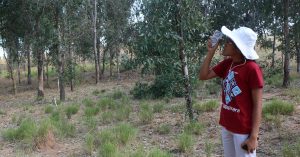A pivotal moment for the reforestation project in Madagascar, is the sustainability and continuity of continuing the reforestation of some two thousand hectares assured? Unfortunately no, financial support to date is insufficient.
4’000 hectares have already been reforested with endemic and indigenous forest species according to the history of the region: Teak, Rosewood, Acacia, Khaya, Terminalia and Eucalyptus.
It should also be remembered that in 2010, when the project for the creation of a “training and forestry development centre” EcoFormation was launched, the objective was to reforest a former primary forest of 6’000 hectares. To reach this objective, we organized the training of apprentices in nursery-forestry trades, the annual production of 1’200’000 seedlings and we involved the local populations in the reforestation of their region at a rate of 700 hectares/year.
Objective partially achieved, however a solution initially integrated into the concept was planned so that the project would be sustainable, although with a few hectares less, we will enhance the value of the reforestation work by checking the reforested area (4000 hectares).
What does this mean? Everyone knows that the forest sequesters the CO2 that we emit, by photosynthesis the carbon is retained by the plants, in this case the trees to form the trunk and the leaf crown, the oxygen is released into the atmosphere.
This operation of transformation of CO2 into Carbon and Oxygen can be measured annually according to the growth of the trees, height and diameter of the trunk, plus volume of the leaf crown. Thus per hectare we can measure the number of m3 of wood acquired from year to year, i.e. the tons of CO2 sequestered each year for tree growth (tCO2/ha).
![]()

The trunk is measured with a large caliper and a measuring device to determine the height (clinometer) and estimate the extent of the leaf crown.
In conclusion, what TUV SUD (verification company) experts have to validate is the number of tons of CO2 sequestered annually by the replanted trees to ensure their growth. These tonnages of sequestered CO2 will be confirmed by “carbon credit” certificates to be marketed on the markets that are obliged to compensate for excess emissions.
